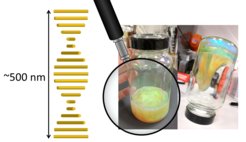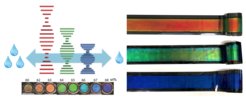
Hydroxypropyl Cellulose Self-Assembly
Hydroxypropyl cellulose (HPC) is a cellulose derivative that exhibits vibrant colours in its liquid crystalline phase and responds to external stimuli. It offers the benefits of being biocompatible and edible, making it a common thickening agent in pharmaceuticals and food products (for example, it serves as a thickener in sauces and dips, as well as a stabiliser in whipped cream).
We are collaborating with Nippon Soda Co., Ltd. to understand the fundamental processes governing HPC self-assembly and to optimise this photonic system for real-world applications.
From Colourless to Coloured: How Does This Happen?
The bright colours associated with HPC are due to a phenomenon known as structural colouration. For instance, a glass of soap and water appears colourless, but when bubbles are formed, the thin shell of the bubbles has dimensions that correspond to the wavelengths of visible light. This transparent layer interacts with light, leading to constructive and destructive interference, which produces rainbow-like colours. The structure responsible for HPC’s colouration is referred to as a cholesteric structure. In this arrangement, the polymer chains self-assemble into a twisted stack that selectively reflects light within a narrow range of wavelengths matching the periodic dimensions of the structure.

Potential Applications of HPC
The cholesteric structure of HPC is created through self-assembly. When mixed with water in the right proportions, HPC—a polymer liquid crystal—spontaneously forms helicoids. This property makes it an easily fabricated, processable coloured material, with colour tuning achievable simply by altering the water content. Additionally, HPC is responsive to changes in pressure and temperature. In our lab, we have investigated how these helicoidal structures react to vertical compression and have created a large-scale pressure sensor using a roll-to-roll machine, allowing us to visually map foot pressure in a way that is easily understood by the human eye.

Current Challenges in Our Research
While a wide range of colours can be achieved by varying HPC concentration, this can complicate further development, as the colours of dry HPC typically fall within the UV spectrum. Our lab is focused on understanding the self-assembly of HPC through optical measurements and developing methods to create a visibly coloured solid-state HPC material.

